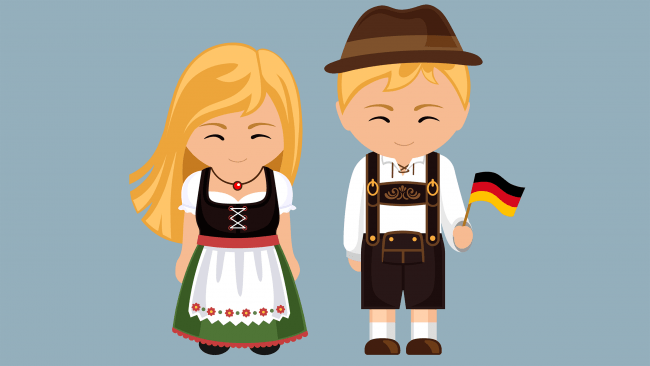The typical clothing of German culture is characterized by its rural origin. At present, it is used in the most important festivals in Germany, such as the Oktoberfest. This clothing varies in each region, but in all it has some common features. Here you will find the characteristics of these traditional costumes.
Below you have an index with all the points that we are going to deal with in this article.
Article Index
- 1.
- 2.
- 3.
- 4.
Dirndl
The traditional dress of women is called Dirndl. Its history originates in rural areas. It is in the 1870th century when the servants of the city began to carry it. However, from XNUMX, the bourgeoisie began to use it, so it became a garment of couture.
The top is made up of a blouse and a corset. Traditionally, the blouse was dyed naturally, so soft colors were worn in spring and summer and dark colors in the cold months, as well as thicker fabrics.
To these garments a skirt, white stockings and an apron are added. Originally, the skirt reaches to the ankles. However, the height of this varies depending on the fashion of the moment.
The way the apron is knotted is loaded with meaning. If the tie is tied to the right, it means that the woman is in a relationship. If she's left, she's single. If the tie is made in the front center, it symbolizes that it is a virgin, while tied behind it reflects that it is a widow.
Typical shoes have a thick heel and are decorated with buckles. The color of these goes together with that of the Dirndl. The fabric used for the suit is cotton or linen, although currently it can also be found in polyester.
It is common for a small pocket on the front or side to be carried at the bottom, as well as for women to adorn themselves with a necklace, a bracelet and a handbag.
Depending on the region, the Dirndl may vary. In the case of Bavaria, typical colors are red, brown, white, green and pink. In the Black Forest, the bollenhut, a big red hat.
Lederhosen
The most important piece of typical German men's clothing is the Lederhosen, which in Spanish means «leather pants«. They have been used since the XNUMXth century, when they began to be worn to work.
There are three types of pants: The one that is above the knee, used mainly by young people (Kurze Lederhose), the one that goes up to the knee (Knee-length leather trousers) and the one that reaches to the ankle (lange lederhose).
El leather pants it usually has a pocket on the right side. Along with these pants, the men wear a plain or plaid shirt and thick wool socks that reach to the calf (Tights).
Traditional shoes are called Haferlschuhe. It is said that its inventor was the shoemaker Franz Schratt, who in 1803 created the first ones inspired by the hooves of the goats.
Sometimes they also wear the tractenhut, a felt hat that has its origin in the Alps. They are usually decorated with a ribbon and a gamsbart, a brush-shaped lock of hair that the lower class began to wear in the XNUMXth century.
In the Bavarian region, the pants are black or brown, while the shirt is usually red, green or blue. Also, in some areas of Germany the Gamsbart is only blue on public holidays.
strive
The entire set of traditional clothing, both men and women, is called strive. In the case of men, to finish the uniform, a jacket is usually added, the Traditional jacket.
This clothing, derived from the regional costumes of Bavaria, is used in important festivals in Germany, such as the Oktoberfest. Also, there are still people who decide to marry in this dress.
The popularity of wearing this clothing resurfaced in 1853, when the Upper Bavarian government decided to revive the spirit of patriotism by taking up some traditions.
Children also wear this clothing, since special sizes are made for them. In the case of girls, they usually wear Dirndls in more cheerful and striking colors.
Today, these outfits can be purchased both in specialized stores and in department stores or the Internet. Such is the success of these suits that they have inspired a clothing line, the Landhausmode.
Volga Germans
People from Germany who migrated to the Lower Volga area, in Russia, from 1763. They did so as a result of the offer of Empress Catherine II to occupy these lands.
These families, over the years, developed their own way of dressing. In the case of men, the most used garments were felt boots (filtzstifel) and fur coats (Schaffelz). The shirts were buttoned and collarless.
As for the women, they were more faithful to the German tradition, but their dresses were grayer and darker. Likewise, they covered their heads with a scarf and did not wear a coat, but instead made their clothes with thick fabrics such as wool.
In the middle of the XNUMXth century, some inhabitants of the Volga began to emigrate to South America, especially Uruguay and Argentina. With the passage of time, they adapted to the local clothing, although the women were more conservative with their clothing.
At present, in populations of descendants of Volga Germans, as is the case of the San Antonio Village, in Entre Ríos, Argentina, they celebrate festivals to return to the customs and typical clothing of Germany.
This article has been shared 59 times. We have spent many hours collecting this information. If you liked it, share it, please:









